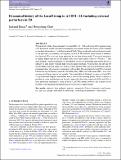Files in this item
Dynamical history of the Local Group in ΛCDM II − including external perturbers In 3D
Item metadata
| dc.contributor.author | Banik, Indranil | |
| dc.contributor.author | Zhao, Hongsheng | |
| dc.date.accessioned | 2017-01-20T15:30:14Z | |
| dc.date.available | 2017-01-20T15:30:14Z | |
| dc.date.issued | 2017-05 | |
| dc.identifier | 248968826 | |
| dc.identifier | 616b692b-ba64-4745-b2d8-91e8aa73a076 | |
| dc.identifier | 85018315969 | |
| dc.identifier | 000398416700067 | |
| dc.identifier.citation | Banik , I & Zhao , H 2017 , ' Dynamical history of the Local Group in ΛCDM II − including external perturbers In 3D ' , Monthly Notices of the Royal Astronomical Society , vol. 467 , no. 2 , pp. 2180-2198 . https://doi.org/10.1093/mnras/stx151 | en |
| dc.identifier.issn | 0035-8711 | |
| dc.identifier.other | ArXiv: http://arxiv.org/abs/1609.04377v2 | |
| dc.identifier.other | ArXiv: http://arxiv.org/abs/1609.04377v2 | |
| dc.identifier.other | ORCID: /0000-0002-4123-7325/work/29708385 | |
| dc.identifier.uri | https://hdl.handle.net/10023/10138 | |
| dc.description | IB is supported by a Science and Technology Facilities Council studentship. | en |
| dc.description.abstract | We attempt to fit the observed radial velocities (RVs) of ~30 Local Group (LG) galaxies using a 3D dynamical model of it and its immediate environment within the context of the standard cosmological paradigm, ΛCDM. This extends and confirms the basic results of our previous axisymmetric investigation of the LG (MNRAS, 459, 2237). We find that there remains a tendency for observed RVs to exceed those predicted by our best-fitting model. The typical mismatch is slightly higher than in our 2D model, with a root mean square value of ~50 km/s. Our main finding is that including the 3D distribution of massive perturbing dark matter halos is unlikely to help greatly with the high velocity galaxy problem. Nonetheless, the 2D and 3D results differ in several other ways such as which galaxies' RVs are most problematic and the preferred values of parameters common to both models. The anomalously high RVs of several LG dwarfs may be better explained if the Milky Way (MW) and Andromeda (M31) were once moving much faster than in our models. This would allow LG dwarfs to gain very high RVs via gravitational slingshot encounters with a massive fast-moving galaxy. Such a scenario is possible in some modified gravity theories, especially those which require the MW and M31 to have previously undergone a close flyby. In a ΛCDM context, however, this scenario is not feasible as the resulting dynamical friction would cause a rapid merger. | |
| dc.format.extent | 19 | |
| dc.format.extent | 2692420 | |
| dc.language.iso | eng | |
| dc.relation.ispartof | Monthly Notices of the Royal Astronomical Society | en |
| dc.subject | Galaxies: groups: individual: Local Group | en |
| dc.subject | Galaxy: kinematics and dynamics | en |
| dc.subject | Dark Matter | en |
| dc.subject | Methods: numerical: data analysis | en |
| dc.subject | Cosmology: cosmological parameters | en |
| dc.subject | QB Astronomy | en |
| dc.subject | QC Physics | en |
| dc.subject | NDAS | en |
| dc.subject.lcc | QB | en |
| dc.subject.lcc | QC | en |
| dc.title | Dynamical history of the Local Group in ΛCDM II − including external perturbers In 3D | en |
| dc.type | Journal article | en |
| dc.contributor.institution | University of St Andrews. School of Physics and Astronomy | en |
| dc.identifier.doi | https://doi.org/10.1093/mnras/stx151 | |
| dc.description.status | Peer reviewed | en |
This item appears in the following Collection(s)
Items in the St Andrews Research Repository are protected by copyright, with all rights reserved, unless otherwise indicated.

